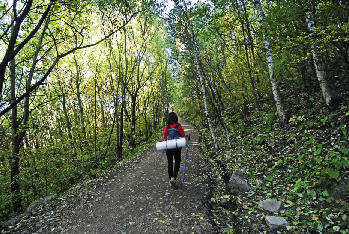Discovering Labagoumen
White Birch and Azalea
 |
| The mountainous road to Fenghuang Platform. |
The climb to the top of Nanhouding is physically testing but worth the effort for the breathtaking panorama along your route.
The birch forest attracts most tourists to Labagoumen. In Chinese culture, birches are acclaimed in literature. There is also a popular Chinese love song about a birch forest by balladeer Pu Shu. So, a lot of young Chinese associate birch forests with love, youthfulness, and nostalgia. For the older generation, birch forests symbolize the vicissitudes of life, a time when Chinese society was changing.
Autumn is the best season to admire the birches, when their golden leaves stand out against the blue sky, a feast for city-weary eyes. The rough, silver trunks look artistically rustic. With its 4,700 hectares of secondary forest, Labagoumen is the town with the largest forest coverage rate in Beijing. Standing there, listening to the rustling of leaves in the wind and observing the sun’s rays piercing the canopy in places, visitors quickly forget the bustling city and dream of escaping here for a few days.
In October 2010, Li Hao, a graduate student in Beijing, was captivated by the beautiful panorama of Labagoumen. It was the first time Li, a native of Hangzhou (capital of Zhejiang Province), had the chance to appreciate the romantic forests of northern China. The trip left her with a completely different impression from that of the gentle view of the West Lake in her hometown. Today, she continues her doctoral studies in Hong Kong, but keeps her memories of Labagoumen alive. For her, the white birch forest represents a part of her youth in Beijing.
The birch leaves are golden for only one week. Then they fall as the temperature drops and the north wind blows. It’s no wonder that such ephemeral beauty causes people to reflect on life and time.
Each May, Labagoumen’s mountains are covered with azaleas in bloom, lasting almost a month. These red flowers reflect a sense of vitality.
In China, azaleas grow mainly in northern China, for example on the Great Khingan, the Changbai Mountains, and Inner Mongolia. They are more rarely found in the Emei Mountains in Sichuan. But they abound in Labagoumen as this town is almost on the same latitude as Inner Mongolia and the altitude is above 1,000 meters. Azalea in Chinese is yingshanhong meaning something “that colors the mountains red.” In Labagoumen, this flower has a light pink hue, which harmoniously blends with the colors of rocks and trees, forming an exceptional landscape.
Tourism Development
In the past, access to Labagoumen was difficult because of its mountainous location; villages are scattered widely and were poorly accessible to traffic. Thus, tourists did not know about its beautiful landscapes. It remained a quiet haven away from any trouble. Over the past decade, Beijing has developed a large-scale transportation network in the suburbs by building a number of roads leading to remote villages. Transport to Labagoumen has, therefore, improved greatly.
Now, for example, at the entrance of Sunzhazi, the road is so wide and clean that you can appreciate the surrounding landscape from inside your car. In the autumn, when the yellow aspen leaves decorate the ground, you can imagine you’re driving through a Canadian forest.
Rural tourism has become one of the pillars of Labagoumen’s economy. To attract visitors, the local government has decided to relocate some locals in the National Forest Park, and build dwellings with Manchu ethnic characteristics. The idea not only protects the ecological environment while building the tourism infrastructure, but also improves the quality of life of inhabitants through paving a path to prosperity. After several years, all villages have formed special tourism projects relying on their own resources. An environment of healthy competition and common development is in place.
Take the example of Sunzhazi Village. Near the entrance to the National Park, this village is the first to have seen the number of houses grow: Each house has two or three rooms reserved for travelers. In competition with other villages, Sunzhazi has sought to improve its tourism service. Many locals have created websites to advertize their inns and allow online booking via mobile platforms. Every hostel is seeking an edge and offers multiple services. Wi-fi has become a must.
We recommend, at night, stargazing from the terrace of a hostel. Do take pictures and post them on social networks and share your experience of rural life with friends. Society develops so quickly these days. It would be a shame for others to miss out on this haven of peace.
|
|
|
The forest tinged with multiple colors. |
WEI YAO is a photographer at Beijing Review.

